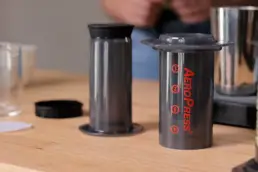Table of Contents
ToggleIntroduction – How To Roast Coffee Beans At Home
If you are like me, once you start brewing your coffee at home, how to roast coffee beans at home becomes a natural progression in your brew coffee at-home journey. Or maybe not. Still, if it ever crosses your mind like mine, below is a simple 7-step guide to roasting coffee beans at home.
Roasting coffee beans at home sounds more complicated than it is. So if you ever want to try, approach it as an exciting experiment. Roasting your beans at home helps you control the flavour and freshness of your coffee, and it’s also a fantastic way to learn more about the beans.
In this guide, we’ll walk you through seven simple steps to start roasting coffee at home, today.
Why Roast Coffee Beans at Home?
Apart from convenience, cost and experimentation, when you roast coffee beans at home, you can:
– Control the flavour to suit your taste preferences
– Ensure you have the freshest coffee possible
– Experiment with different beans and roasting techniques
What You Need to Get Started
Before you begin your home coffee roasting journey, ensure you have the following:
– Green coffee beans (You can buy unroasted beans from Zuma Coffee)
– A roasting device (options include a popcorn popper, stovetop pan, or coffee roaster)
– A Sieve/strainer for cooling the beans after roasting
– An airtight container for storing your roasted beans

Seven Steps to Roast Coffee at Home
Step 1: Choose Your Green Coffee Beans
Green coffee beans are the raw seeds of the coffee plant and can come from various regions around the world. Consider the bean’s origin and variety of coffee beans. Arabica beans are generally considered higher quality than Robusta, but both have distinct flavours.
Step 2: Choose the Roasting Method
There are several methods for roasting coffee at home, each with its pros and cons:
Using a Popcorn Popper:
– Pros: Inexpensive and easy to use
– Cons: Limited control over the roast
– How to: Place about 1/2 cup of green beans in the popper, turn it on, and stir occasionally. Listen for the “first crack” (sounds like popcorn popping) and choose your preferred roast – for a light roast, stop shortly after the first crack and for a darker roast, wait for the second crack. Pour the beans into a sieve and shake to cool quickly.
Stovetop Pan Roasting:
– Pros: More control over the process
– Cons: Requires constant attention and stirring
– How to: Heat a heavy skillet or pan on medium-high heat, add a single layer of green beans, and stir constantly to ensure even roasting. Listen for the first and second cracks to gauge the roast level. Pour the beans into a sieve and shake to cool.
Using a Coffee Roaster:
– Pros: Offers good control and consistent results
– Cons: Generally expensive
– How to: Follow the manufacturer’s instructions for your specific model. Load the green beans, set your desired roast level, and start the machine. Monitor the roast and adjust settings if needed. Cool the beans as directed by the roaster’s instructions.

Step 3: Prepare Your Roasting Area
Roasting coffee can produce smoke and a strong aroma, so make sure your roasting area is well-ventilated. Open windows, use fans or roast outside where possible. Keep a fire extinguisher nearby and avoid roasting near flammable objects.
Step 4: Start Roasting
Begin roasting your beans using your chosen method. Pay close attention to the beans’ colour and listen for the cracks to gauge the roast level. Approximate roasting times:
– Light roast: 4-6 minutes
– Medium roast: 6-8 minutes
– Dark roast: 8-10 minutes
Step 5: Cool the Beans
Once the beans are roasted to your preference, cool them quickly to stop the roasting process. Pour the beans into a metal sieve and shake or stir them to help them cool. Alternatively, use a baking sheet and spread the beans out in a single layer.
Step 6: Store Your Roasted Beans
After the beans have cooled completely, store them in an airtight container away from direct sunlight and moisture. Keep them in a cool, dark place. For optimal flavour, use roasted beans within two weeks.
Step 7: Brew and Enjoy
Brew your freshly roasted beans using your preferred method and enjoy the rich, flavourful coffee you’ve created. Experiment with different brewing techniques to find the perfect cup.

Tips for Successful Home Coffee Roasting
– Ensure proper ventilation when roasting coffee to avoid smoke buildup.
– Experiment with different beans, roasting times, and methods to discover your preferences.
– Keep records of each roast, including the bean type, roasting time, and temperature, so you can replicate or adjust your method for future batches.
Understanding Roast Levels
Roasting coffee at home allows you to control the flavour by adjusting the roast level. Here are the main stages of coffee roasting and their flavour profiles:
Light Roast:
– Characteristics: Light brown colour, no oil on the surface
– Flavor: Retains most of the beans’ original flavours, often fruity or acidic
– Roasting Stage: Stopped shortly after the first crack
Medium Roast:
– Characteristics: Medium brown colour, balanced flavour
– Flavor: Slightly sweeter than light roasts, with balanced acidity and body
– Roasting Stage: Stopped after the first crack but before the second crack
Dark Roast:
– Characteristics: Dark brown to black colour, oily surface
– Flavor: Bold, smoky flavour with low acidity; original flavours of the beans are less pronounced
– Roasting Stage: Continued through the second crack
Common Issues
– Uneven Roast: Stir the beans constantly if using a pan
– Burnt Flavor: Roast at a lower temperature or shorten the roasting time.
– Underdeveloped Flavor: When you roast coffee beans at home, you may produce an underdeveloped flavour. In that case, roast for a bit longer or increase the temperature slightly.

Conclusion
Choosing to roast coffee beans at home is a fantastic way to dive deeper into the world of coffee. It allows you to control the flavour and freshness of your brew, giving you a truly personalized coffee experience. With a few basic tools and some practice, you’ll be roasting coffee like a pro in no time.
Ready to start roasting coffee at home? Grab some green beans, choose your preferred roasting method, and enjoy the journey to the perfect cup! Share your home roasting experiences and any tips you discover in the comments section below.
See this short video on how to roast coffee beans at home using a pan.

esewalter
Mom | Yoga Teacher | Coffee Blogger | Legal Mind. I explore coffee's journey from farm to cup and especially how you can start your home brewing journey.



